
CREDIT ENHANCEMENT
FOR GREEN PROJECTS
Promoting credit-enhanced nancing
from multilateral development banks
for green infrastructure nancing
iisd.org
Madhu Aravamuthan
with Marina Ruete
and Carlos Dominguez
May 2015
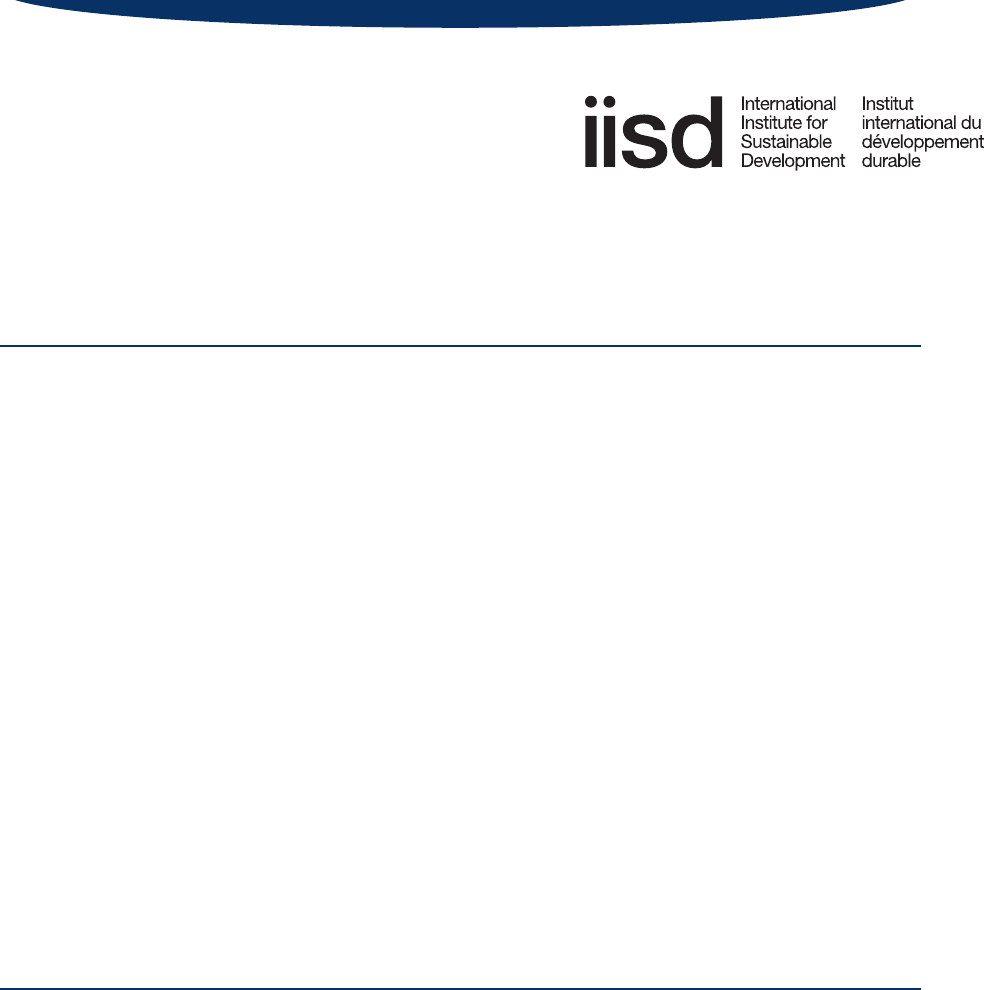
Credit Enhancement for Green Projects ii
© 2015 The International Institute for Sustainable Development
Published by the International Institute for Sustainable Development.
International Institute for Sustainable Development
The International Institute for Sustainable Development (IISD) contributes to sustainable development by advancing
policy recommendations on international trade and investment, economic policy, climate change and energy, and
management of natural and social capital, as well as the enabling role of communication technologies in these areas.
We report on international negotiations and disseminate knowledge gained through collaborative projects, resulting
in more rigorous research, capacity building in developing countries, better networks spanning the North and the
South, and better global connections among researchers, practitioners, citizens and policy-makers.
IISD’s vision is better living for all—sustainably; its mission is to champion innovation, enabling societies to live
sustainably. IISD is registered as a charitable organization in Canada and has 501(c)(3) status in the United States. IISD
receives core operating support from the Government of Canada, provided through the International Development
Research Centre (IDRC), from the Danish Ministry of Foreign Aairs and from the Province of Manitoba. The
Institute receives project funding from numerous governments inside and outside Canada, United Nations agencies,
foundations and the private sector.
Head Oce
161 Portage Avenue East, 6th Floor, Winnipeg, Manitoba, Canada R3B 0Y4
Tel: +1 (204) 958-7700 | Fax: +1 (204) 958-7710 | Website: www.iisd.org
Geneva Oce
International Environment House 2, 9 chemin de Balexert, 1219 Châtelaine, Geneva, Switzerland
Tel: +41 22 917-8373 | Fax: +41 22 917-8054 | Website: www.iisd.org
Credit Enhancement for Green Projects
Promoting credit-enhanced financing from multilateral development banks for green infrastructure financing
May 2015
Written by Madhu Aravamuthan with Marina Ruete and Carlos Dominguez

Credit Enhancement for Green Projects iii
Executive Summary/Methodology
This paper seeks to identify, review and understand credit-enhancement schemes provided by multilateral
development banks and international financial institutions. It does this to determine, through the analysis of case
studies, the applicability of such credit-enhancement mechanisms to infrastructure and green infrastructure projects.
This analysis is intended to provide a basic notion of the challenges faced by the various participants in obtaining and
assigning financing for both infrastructure and green projects.
The paper starts by defining its central terms, infrastructure and green infrastructure. This first chapter briefly reviews
the terms to underscore the fact that the diculty in defining them reflects the complex nature of the projects seeking
investment. It then continues with an overview of traditional credit-enhancement schemes, with a more specific look
into the schemes oered by various multilateral development banks. Chapter Three then analyses, through three
examples of successful credit-enhancement schemes for both general and green infrastructure projects, the possible
applications of such schemes for future projects.. The paper concludes with a summary of challenges identified and
goals for the future.
While this paper is based on policy and research, interviews with relevant personnel at multilateral development
banks were extremely helpful in providing a perspective on internal processes, investment goals, green infrastructure
promotion and general practices regarding infrastructure development.
The authors are grateful to the following persons for their time and eorts in providing us valuable input:
• Pradeep Singh, Deputy Dean Indian School of Business; former Vice-Chairman and CEO, Infrastructure
Development Finance Company (Projects) Ltd.
• James Close, Director, Climate Change Group, PPIAF, World Bank
• Matthew Jordan-Tank, Head of infrastructure policy, European Bank for Reconstruction and Development
• Jan van Schoonhoven, Counsellor Infrastructure and Public-Private Partnerships, United Nations Economic
Commission for Europe
• Satheesh Sundararajan, Infrastructure Finance Specialist PPIAF, International Bank for Reconstruction and
Development
• Tomoko Matsukawa, Senior Financial Ocer, Financial Solutions, World Bank
• Vivek Rao, Senior Project Ocer, Asian Development Bank
• María Netto Schneider, Lead Capital Markets and Financial Institutions Specialist, Inter-American
Development Bank
• Malik Faraoun, Principal Investment Ocer, Infrastructure Finance and PPP, African Development Bank
• Martin Berg, Investment Ocer, Climate Change & Environment, New Products & Special Transactions,
European Investment Bank

Credit Enhancement for Green Projects iv
Table of Contents
Chapter 1. Green Infrastructure Financing .........................................................................................................3
Defining Matters .................................................................................................................................................3
Green Infrastructure Financing .......................................................................................................................4
Chapter 2. Credit Enhancement ........................................................................................................................... 7
Multilateral Development Banks – Credit-enhancement schemes ...................................................9
African Development Bank (AfDB) ..................................................................................................... 10
Asian Development Bank (ADB) .......................................................................................................... 11
European Bank for Reconstruction and Development (EBRD) ................................................... 11
European Investment Bank (EIB) ......................................................................................................... 12
Inter-American Development Bank (IADB) ..................................................................................... 12
International Finance Corporation (IFC) ............................................................................................ 13
World Bank Group (World Bank, MIGA, IBRD) .............................................................................. 13
Chapter 3. Case Studies on Credit Enhancement ......................................................................................... 15
Successful Credit-Enhancement Projects ................................................................................................. 15
Asian Development Bank: India – IIFCL (2012) .............................................................................. 15
World Bank Group: Nigeria – Power Sector Guarantees Project (2014) ..................................... 17
Inter-American Development Bank: Mexico - Geothermal Project (2014) ..........................18
Chapter 4. Risk Mitigation in Green Infrastructure ....................................................................................... 21
Chapter 5. Conclusions ......................................................................................................................................... 23
References .................................................................................................................................................................. 25
Annex A. Internal Processes at MDBs ..............................................................................................................27

Credit Enhancement for Green Projects 1
Introduction
The year 2015 brings important discussions on infrastructure development. The G-20 summit in late 2014 put
infrastructure in the limelight with the setting up of the Global Infrastructure Hub that could help unlock private
infrastructure spending and governments recommitting to help bridge the infrastructure gap. This year is also the
setting of the Sustainable Development Goals (SDGs) by the UN General Assembly in which all stakeholders will
participate. Some of these SDGs
1
expressly relate to infrastructure and public–private partnerships, highlighting
their significance in the upcoming years. The World Economic Forum (WEF) in 2015 also focused quite heavily on
infrastructure development benefits and means to achieve the same with increased private investment.
This paper looks at infrastructure development from a definite angle. We review and consider the credit-enhancement
schemes provided by multilateral development banks (MDBs) and international financial institutions (IFIs). While
infrastructure as a whole is a concern, this paper examines it with a view to promoting credit-enhanced financing
from such institutions for green infrastructure projects. With increasing climate challenges and need for infrastructure
development, it is necessary for countries to embrace growth in terms of green projects. This focus is borne out of
a need to mainstream green infrastructure developments and provide them greater access to the sizeable private
funding available. The usually accessible sources of financing, such as debt financing (commercial loans or bonds) or
government support (subsidies) are insucient to meet the global target for infrastructure investment and particularly
green infrastructure. This is exacerbated by the reality that green infrastructure presents dierent and new risks
(and the perception that its risks are more plentiful and severe) that need to be mitigated. Credit-enhancement
instruments are facilitators of access to private funding—they raise the credit standing of projects, enabling them to
attract various other sources of financing.
The issue of leveraging private financing for infrastructure was also raised at the WEF, where a dedicated solution
was mooted—a special entity capitalized by donor countries, private banks and IFIs that would provide partial
guarantees to cover risks in projects. This is an excellent proposition, which, if implemented, would address several
financing concerns. However, at present, it is important to maximize the available sources of financing and credit
enhancement. This is especially important in an era where the funding of green infrastructure projects is being
thoroughly scrutinized. Attracting new and sizeable investment to finance green projects is a dicult proposition, but
one that can be achieved through understanding and application of existing and new methods of financing.
This paper provides an overview of the mechanisms available under credit-enhancement schemes provided by MDBs
and IFIs in order to understand how they can be used to garner greater private sector investment. While a variety of
credit-enhancement products have been floated by MDBs and IFIs, they are not deployed to a large extent due to
several factors. A brief review of successfully credit-enhanced projects presents anecdotal evidence and potential
for future projects in mitigating risk and obtaining private financing. Greater progress can be achieved with a more
eective utilization of these instruments through innovative combinations, knowledge dissemination and entrenched
partnerships between MDBs, project developers, private banks and governments.
1
The SDGs have been built upon to further the Millennium Development Goals and specifically refer to infrastructure development in Goals
7, 9 and 11.
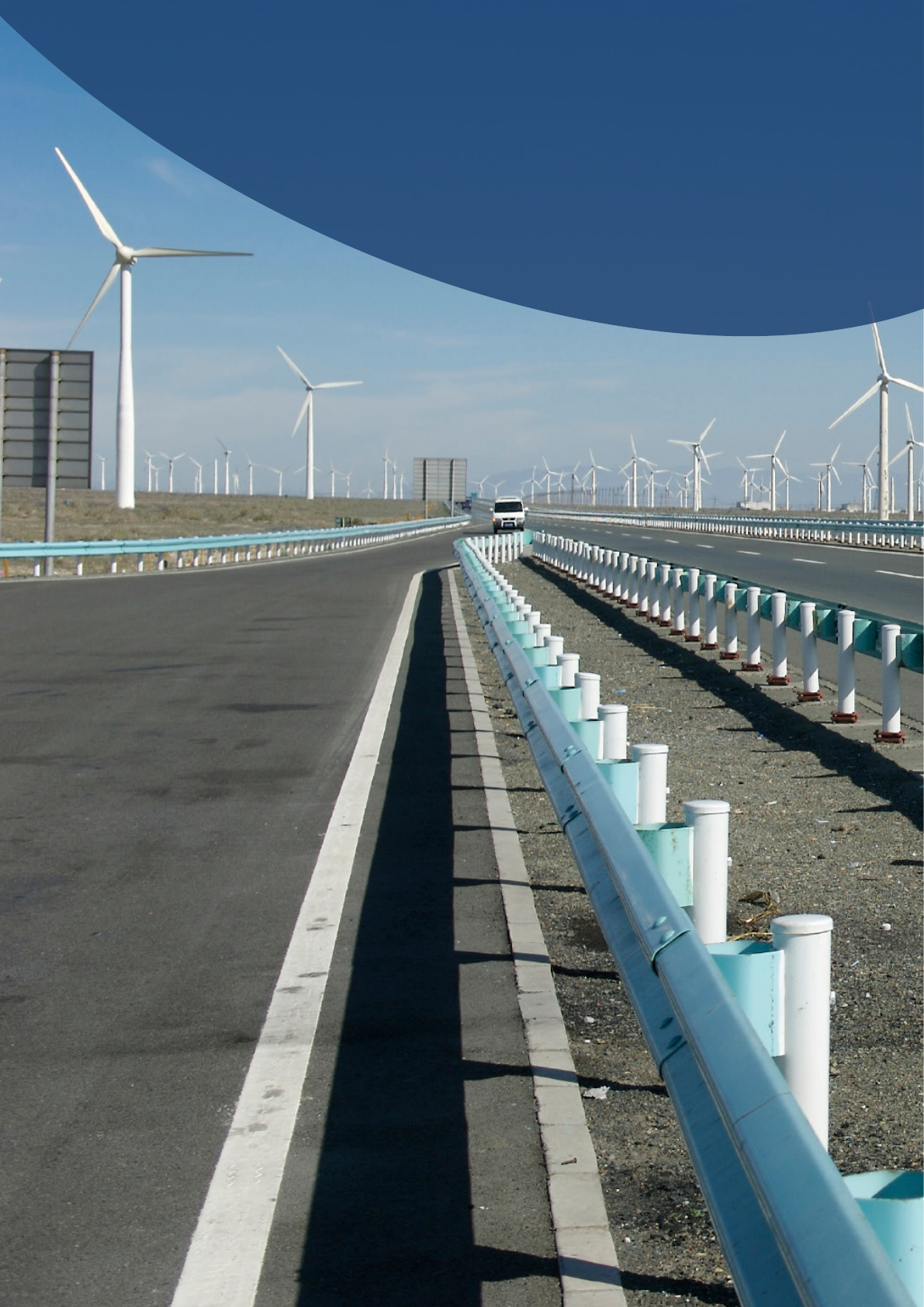
Credit Enhancement for Green Projects 2
CHAPTER 1.
GREEN INFRASTRUCTURE
FINANCING

Credit Enhancement for Green Projects 3
Chapter 1. Green Infrastructure Financing
Dening Matters
Governments have benefited from private sector involvement in infrastructure projects boosting many times the
number of available resources and, hence, of projects. The large investment associated with infrastructure projects
has both daunted and lured investors at the same time.
While defining infrastructure is a complex endeavour, it can generally be construed as including “facilities, structures,
equipment, or similar physical assets – and the enterprises that employ them”.
2
The term “infrastructure” alone lends
itself to circumstantial definition by determining whether or not a specific structure will be developed on the basis of
its characteristics. It could refer to both physical
3
and social infrastructure
4
together when referring to government
responsibilities but independently when considering potential investment opportunities. For the purposes of this
paper, the term “infrastructure” refers only to physical structures and not social infrastructure.
The size of infrastructure projects and the large investments that they entail make them inherently complex and
beset with hurdles for investors, financiers, governments and the many stakeholders the structure allows. Risk
assessments, coordination of roles, visualization of the implementation phase, and other legal, administrative
and political problems scare investors and financers away from these projects. Over the last couple of decades,
myriad innovative financial models have appeared tailor-made for the actors´ needs or conditions, sectors, type of
infrastructure, country or region particularities, among others.
While it is imperative to provide a comprehensive definition of the term “green infrastructure” in order to develop a case
for extensive credit-enhancement mechanisms among other financing methods, it is also important to understand
the evolving and competitive nature of such a definition. The definition of green infrastructure also varies on the basis
of context and depends on several dierent factors—some of the more obvious are the institutional or academic
purpose, the intended audience or the results expected, or whether it is an investment or ecological discussion. It is
imperative for green infrastructure to develop to accommodate the changes and challenges arising out of new green
technological advancements, which in turn evolve from a greater understanding of the environmental concerns and
issues. A narrow definition of “green” risks excluding such new creations, while one that is too broad might not
be purposeful. The OECD, in its stocktaking exercise on what constitutes green investments, reviews the types of
definitions and their features to suggest that an “open and dynamic approach” and a “competition of definitions and
standards” may be a more productive strategy (Inderst, Kaminker, & Stewart, 2012, p. 7).
A non-exclusive list of infrastructure considered “green” for the purpose of this paper, includes:
(1) Low-carbon energy or energy-ecient infrastructure: Infrastructure that includes processes that produce
climate benefits.
(2) Renewable energy projects: generation or derivation of “energy from natural processes (e.g. sunlight and
wind) that are replenished at a faster rate than they are consumed. Solar, wind, geothermal, hydro and some
forms of biomass are common sources of renewable energy” (International Energy Agency, 2015).
(3) Green buildings: “Green building is the practice of creating structures and using processes that are
environmentally responsible and resource-ecient throughout a building’s life cycle from siting to
design, construction, operation, maintenance, renovation and deconstruction. This practice expands and
2
A Harvard Law School study by Larry Beeferman and Allan Wain (2013), reviews the origin and contexts of the term “infrastructure”
to provide a comprehensive definition: “Facilities, structures, equipment, or similar physical assets—and the enterprises that employ
them—that are vitally important, if not absolutely essential, to people having the capabilities to thrive as individuals and participate in
social, economic, political, civic or communal, household or familial, and other roles in ways critical to their own well-being and that of their
society, and the material and other conditions which enable them to exercise those capabilities to the fullest.”
3
The physical and organizational structures that form the backbone of any nation such as roads, dams, and power plants. Also see
Beeferman and Wain (2013).
4
Social infrastructure includes provision of social services such as health care, education, emergency services and cultural establishments.

Credit Enhancement for Green Projects 4
complements the classical building design concerns of economy, utility, durability, and comfort. Green
building is also known as a sustainable or high performance building” (Environmental Protection Agency,
n.d.).
(4) Modified green: The addition, modification or updating of existing structures to convert them from
conventional or brownfield infrastructure to include features of green building.
Green Infrastructure Financing
Global procurement trends are pushing the private sector to invest and finance in environmentally friendly products
and services. Infrastructure needs to follow suit. Certain studies estimate that green infrastructure requires between
US$36–42 trillion in investments between 2012 and 2030 or 2 per cent of global GDP per year (Kaminker, Kawanishi,
Stewart, Caldecott, & Howarth, 2013).
However, when adding this “green” characteristic to infrastructure finance, the already complicated nature of project
finance is intensified. Some of the reasons why it is dicult to mobilize capital into these projects is that most
government agents lack of knowledge about the risks and are unfamiliar with the gains of “greening” infrastructure.
Partnerships among governments, investors, financial institutions, civil society and international organisations are
crucial for accelerating green infrastructure growth. However, there is a need for forward-thinking action plans to
allocate the best knowledge, role and risk to each partner in order to increase value for money of green infrastructure
projects.
Globally, public–private partnerships (PPP) are the most preferred method of sourcing private investment for
infrastructure projects, though there are certain very specific methods and innovative initiatives when it comes to
green infrastructure financing. According to the OECD (Kaminker et al., 2013) the dierent financing structures
attracted by green infrastructure include:
• Indirect corporate investments such as corporate bonds, publicly listed equity and mezzanine finance.
• Semi-direct venture capital/private equity funds investing in green companies or straight into projects and
asset-backed securities.
• Direct investment into green infrastructure projects through equity, debt or PPPs.
The systemic requirements of green infrastructure financing are often met through focused project or infrastructure
development funds and viability gap funds.
5
From green infrastructure bonds
6
to PACE bonds,
7
capital markets have
participated in several new formats of raising funds for green infrastructure development. Bloomberg New Energy
Finance (BNEF) has identified that a record US$38 billion was invested in green bonds in the year 2014 alone; with
both institutional (World Bank) and corporate bond issuers (Unilever, GDF Suez) stepping up their oerings (BNEF,
2015).
Participants in green infrastructure finance have diversified their investor base, with governments of developing
countries seeking to green their infrastructure growth with inventive programs and partnerships. For example,
India’s National Solar Mission is an example of green infrastructure being given top priority notwithstanding political
changes; national interests are pushing Kenya’s Climate Change Action Plan towards greener infrastructure and
Brazil’s sustainable climate-smart agriculture programs have been promoted heavily over the past few years (World
Economic Forum, 2012; African Development Bank, 2011; Kaminker, Kawanishi, Stewart, Caldecott, & Howarth,
2013). The increased involvement of governments in promoting green growth has also lead to the formation of new
and interesting structures for project developers to work with governments, MDBs and private investors. MDBs, for
5
For a brief explanation of project development funds and viability gap funds, please see Box C in Chapter 2 below.
6
The popularity of green bonds can be seen in its spread to developing markets. For instance, India launched its very first green
infrastructure bond recently (“Yes Bank,” February 2015).
7
Property Assessed Clean Energy (PACE) is a means of financing energy efficiency upgrades or installing renewable energy for existing
buildings. For instance, the state of California launched the largest clean energy PACE program in the United States (September 2014)
(Gerdes, 2012).

Credit Enhancement for Green Projects 5
their part, have greater interest in investing in projects that are considered green or climate friendly, as defined by
their internal processes. For instance, the Inter-American Development Bank (IADB) dedicates at least 25 per cent
of its investment capital towards those projects that have a “climate positive impact” and the European Investment
Bank (EIB) also has the same target of 25 per cent for projects considered green.
8
These new structures entail the participation of many actors with dierent roles in risk taking. Pension funds, for
example, which account for large amounts of capital, may be mandated to invest in green projects. Other private
investors may have capital limits on the amount they invest in projects that do not receive top credit grading.
However, green infrastructure poses high risks given its uncertainties. Governments are usually unable to bear all
risks associated with such large infrastructure projects. It is then key for an enabling actor to be present in order to
ameliorate certain risks and thus improve the standing of the project. This will in turn provide confidence to other
investors about the project and the returns it is capable of producing. National and multilateral development banks
have appeared on the scene as such credit enhancers of infrastructure projects, and particularly green infrastructure.
While there are dierences in the present and perceived risks in regular infrastructure projects and green infrastructure
projects, the internal processes at MDBs for risk assessment and financing these projects is quite the same or mostly
similar.
8
Information gathered from interviews with personnel at the IADB and the EIB.
TEXT BOX A. DIFFERENT DEFINITIONS OF “GREEN INFRASTRUCTURE” BY DIFFERENT ACTORS
Academy
An interconnected network of natural areas and other open spaces that conserves natural ecosystem values and
functions, sustains clean air and water, and provides a wide array of benefits to people and wildlife.
Source: Benedict & McMahon (2006).
International Institutions
Creating more sustainable economies and communities by emphasizing that policies that favor environmentally
sustainable growth should have a more prominent role in development criteria and plans.
Baietti, Shlyakhtenko, Rocca & Patel (2012).
A “competition of definition and standards” has the benefit of making productive use of the full breadth of knowledge
available. It may beneficial for climate change-related investing across the full range of opportunities, ranging from for
new funds for innovative ventures to moving the traditional economy into a greener direction.
There is a sizeable common intersection of the various definitions in terms of sectors (e.g., renewable energy), goods
(e.g., lead-free fuel), services (e.g., water and waste management), technologies and processes (e.g., to enhance energy
eciency).
Regional and National Organizations
A strategically planned network of natural and semi-natural areas with other environmental features designed and
managed to deliver a wide range of ecosystem services. It incorporates green spaces (or blue if aquatic ecosystems are
concerned) and other physical features in terrestrial (including coastal) and marine areas. On land, GI is present in rural
and urban settings.
Source: European Commission, (2013), p. 3.
Green infrastructure is an approach to wet weather management that uses soils and vegetation to utilise, enhance and/
or mimic the natural hydrologic cycle processes of infiltration, evapotranspiration and reuse.
Source: US Environmental Protection Agency (2008).
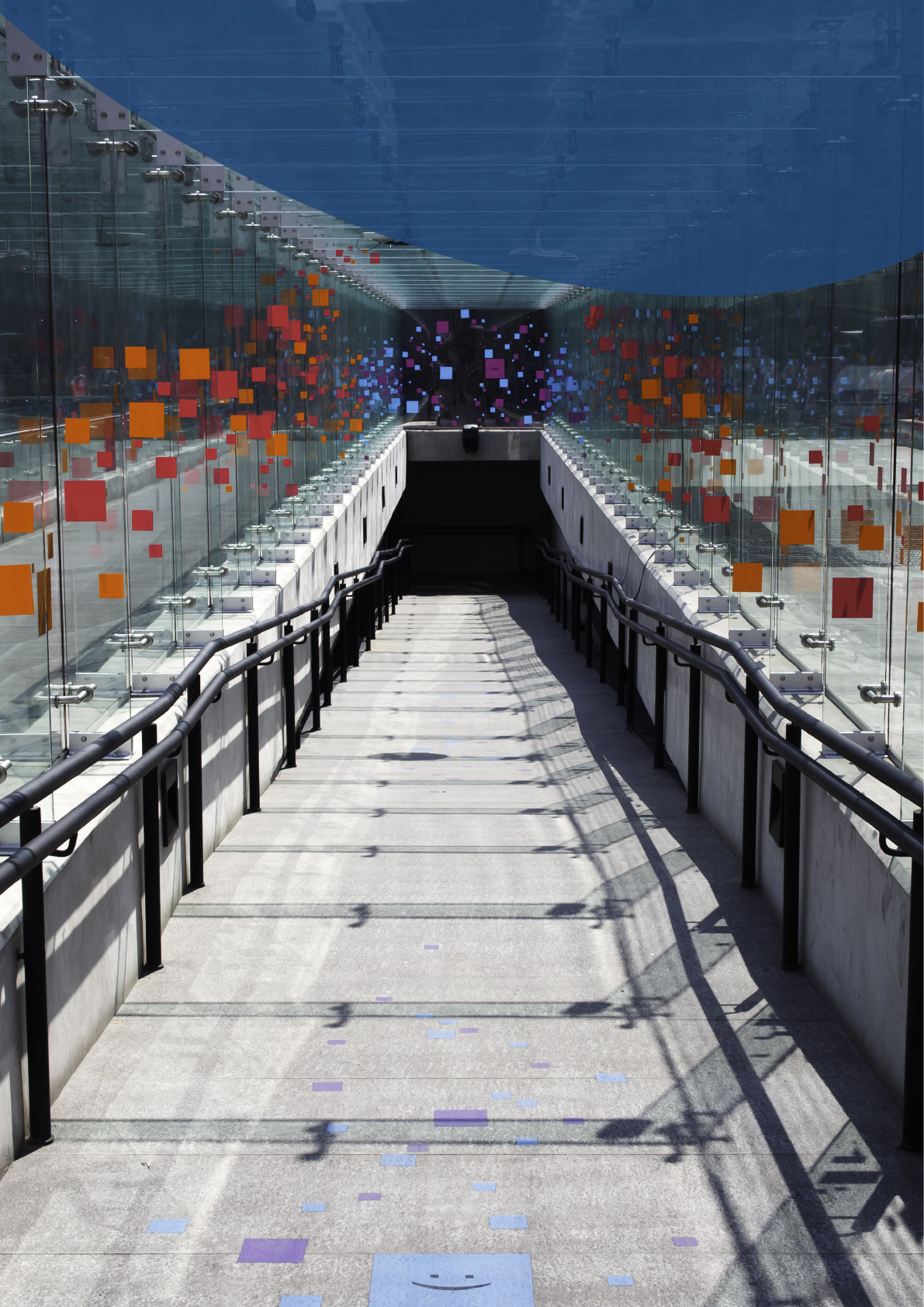
Credit Enhancement for Green Projects 6
CHAPTER 2.
CREDIT ENHANCEMENT

Credit Enhancement for Green Projects 7
Chapter 2. Credit Enhancement
This chapter provides an introduction to dierent types of credit-enhancement mechanisms and a brief overview of
those oered by MDBs. In order to understand the need for credit enhancement, it is first essential to review both the
reasons for it and the risks inherent in infrastructure projects.
There has been increasing demand for infrastructure development over the past few decades, with an increased focus
on commensurate economic growth. With this demand came the requirement for innovative financing solutions for
infrastructure projects, especially in developing countries. Also, developing countries present a financing gap, which
has been widened as a result of the financial crisis and new banking regulations (Basel II and Basel III).
Infrastructure projects present a less-attractive option than other long-term projects. There are usually significant
upfront costs involved (that may be even greater in green infrastructure) that are dicult to match with the project’s
cash flow over its life cycle as well as infrastructure-specific risks that are dicult to mitigate. Infrastructure projects
also pose particularized risks that could dier depending on the borrower or investor. For MDBs and development
financial institutions, the main risks arise from lending to sovereign and sub-sovereign entities. These could range
from (a) political risks (regulatory risk, permits and permissions risk, expropriation risk, market-distortion/corruption
risk),
9
(b) credit risk (tari risk, cash flow risk, interest rate risk), (c) environmental risk (d) technical/technological
risk (especially new technology risk for green infrastructure) and other forms of risk. The degrees of influence of these
risks is inherent based on:
(1) The type of borrower (sovereign or sub-sovereign entity, SPV).
(2) Nature of the project (contracts—such as Build-Operate-Transfer or “BOT,” limited recourse, revenue based
lending—sectoral dierences between roads, power, green infrastructure that cause technical and physical
risks).
(3) The issues in the country where it is deployed (some developing countries have specific issues such as
political uncertainty, lack of a developed financial market, etc.).
In addition to the risks set out above, green infrastructure projects face specific challenges. A recent CPI paper looks
at the classification of green investment risks perceptions, noting that when it comes to green infrastructure, the
political risks are amplified due to the increased reliance on public support; technological risks are complicated by the
overwhelming presence of new, cutting-edge technology that is untested in markets to inspire sucient confidence;
and the long payback periods combined with high upfront costs increase the market and commercial risks (Frisari,
Herve´-Mignucci, Micale, Mazza, 2013).
Credit-enhancement schemes respond to the demand to mitigate the risks of the project and attract further financing
and investment to the project. It is an external mechanism that seeks to increase the credit rating/credit worthiness
of the financeable aspects of an infrastructure project. The main objective of a credit-enhancement mechanism is
to ameliorate the credit quality of infrastructure projects that have already achieved a certain minimum threshold,
in order to attract more private financing for the project. The various mechanisms typically employed by multilateral
banks and development financial institutions are detailed in Boxes B and C below.
9
A recent report (WEF, 2015) by the World Economic Forum analyses the various types of political and regulatory risks in infrastructure
projects and methods for their mitigation. The report looks at the risk landscape in different phases of the project (planning/ construction,
operation and termination) and identifies political and regulatory challenges that need to be mitigated, such as the risk of cancellation or
change of scope of project, environmental permits, local community opposition, expropriation, breach of contract, regulatory changes,
taxation changes, judicial and corruption risks.

Credit Enhancement for Green Projects 8
TEXT BOX B. GUARANTEES AS CREDIT-ENHANCEMENT MECHANISMS
Guarantees are used in project finance to stabilize financing and reassure the lenders and investors they will be repaid.
Guarantees usually have easy triggering methods in case of default. As credit-enhancement mechanisms, the dierent
types of guarantees available seek to cover a specific risk or portion of the debt.
Partial Credit Guarantee (PCG)
A partial credit guarantee is created to absorb part or all the debt service default risk of an infrastructure project,
irrespective of the cause of default. This is particularly helpful to improve a project’s credit profile, enabling it to garner
a wider array of investors and better terms for the debt agreement.
PCGs can be used for any commercial debt instrument (loans, bonds) from a private lender. The existence or proposed
implementation of a PCG is indicative of confidence in the product being floated by the government and can even assist
in bringing new lenders to the table.
Political Risk Guarantee (a.k.a. Partial Risk Guarantee) (PRG)
PRGs cover private lenders and investors for certain risks of lending to sovereign or sub-sovereign borrowers. Thus, by
definition, a PRG necessarily needs to include private participation in the project.
A PRG can cover a number of sovereign or sub-sovereign risks such as currency inconvertibility, political force majeure
such as war, regulatory risk and government payment obligations (such as taris). PRGs are used quite often and
favourably in green energy/energy eciency projects.
TEXT BOX C. OTHER CREDIT ENHANCEMENT MECHANISMS
First-loss provisions
First-loss provisions refer to any device designed to protect investors from the loss of capital that is exposed first if
there is a financial loss of security. These could be debt, equity or derivatives instruments such as cash facilities or
guarantees. They could also take the form of monoline insurances that insure debt security providers who are liable to
pay compensation to the investors, irrespective of the cause of the loss. This helps by shielding investors from a defined
initial amount of losses, thereby improving the creditworthiness of an investment.
Contingent loans
Contingent loans are often used in project finance to backstop the main debt by providing a payment option for specific
case scenarios (for instance, in case of a failure of the government to obtain quality cash flows, the contingent loan is
triggered and investors paid). This mechanism is extremely helpful, especially since the provision of a loan contingent
on the risks that private investors would not want to take on creates a more conducive atmosphere for government
projects to be invested in.
Viability gap funding (VGF)
VGF is used specifically and heavily in infrastructure to cover for the heavy upfront funding that is required to kick start
projects. An analysis of the viability of a proposed project points out the weak areas that prevent large-scale funding
from being obtained. A VGF scheme can be implemented through capital grants, subordinated loans or even interest
subsidies to target specific issues that are aecting the viability of the project. For instance, if the long-term acquisition
of tolls from the project is a deterring risk, then a grant or guarantee from the government in the PPP road project
increases the viability of the project to obtain private investment.

Credit Enhancement for Green Projects 9
Some infrastructure finance specialists also include A/B loans or grants in the definition of credit-enhancement
mechanisms. Under the A/B loans programs, MDBs oer the “A” portion of the loan while attracting other lenders to
join in a second (or “B”) tranche. The MDB will be the lender-of-record, lead lender and administrative agent in the
transaction. The benefit to the additional lenders (the “B” lenders) is that it reduces part of the risks of the operations,
by also being covered by the “umbrella” of the MDBs that include a preferred creditor status and de jure immunity
from taxation.
Often, these mechanisms are used in combination (with each other or other financing schemes) to achieve a more
eective project. For instance, for Chilean toll road construction, the IADB provided a blend of financial guarantee and
an A/B financing in bond transactions. The resultant guarantor-of-record structure extended the preferred creditor
status to monoline insurers thereby giving risk protection that allowed private insurers to enter the market. Similarly,
to support a pipeline project in West Africa, the World Bank oered a partial risk guarantee while the Multilateral
Investment Guarantee Agency (MIGA) oered political risk insurance that would cover payments owed by the
government (Matsukawa & Habeck, 2007).
Another example of credit-enhancement mechanisms being used in conjunction with other structures is the Global
Energy Eciency and Renewable Energy Fund (GEEREF) launched by the EIB, which includes a first-loss provision
by donors to cushion risk absorption for senior lenders and private investors. This system uses credit-enhancement
techniques within detailed equity structures to achieve greater coverage of potential projects.
The purpose of credit-enhancement schemes is to identify the weaknesses in the financial viability of a project and
improve them to make it more attractive to investors and financers. Private debt finance sources usually come from
bond investors (e.g., pension funds, insurance investors, private debt funds) and commercial banks. Such private
financiers are look for investment-grade rated projects, which means that high-risk projects (including infrastructure
projects) are not of interest to them. The participation of the private sector is key for the viability of infrastructure
projects. Without the assistance provided by credit-enhancement mechanisms, many projects remain unfeasible
and unable to garner private financing. The weakening of the global economy with increased austerity measures and
decreased investment capacity, new banking regulations under Basel II and Basel III, and the perception of high-risk
in infrastructure projects have kept private investors away, especially in developing countries.
10
Unlike direct lending, credit-enhancement schemes: (1) may improve credit rating and/or interest rates of the project;
(2) may raise the profile of the project by boosting confidence in the creditworthiness of the project. Both these
characteristics further the chances of future investments. These benefits are crucial in their ability to mainstream
financing and investors into infrastructure projects.
Multilateral Development Banks – Credit-enhancement schemes
MDBs have traditionally deployed funds in the form of loans, investment or capacity building. The years of experience
and knowledge of the demands in countries have opened their field of work to other financial products, including
credit-enhancement products, which have increased over the last decade.
The World Economic Forum recommended in 2006 that MDBs activities “should shift over time from direct lending
to facilitating the mobilization of resources from the world´s largest private saving pools—international or domestic—
for development-oriented investments through . . . wider use of risk mitigation instruments to alleviate part of the
risk faced by investors (World Economic Forum, 2006). This focus has not shifted completely, but MDBs are oering
credit-enhancement mechanisms as part of the portfolio of products to their member countries.
10
The main concerns for infrastructure financing arising from Basel III are due to the requirements under the Liquidity Coverage Ratio, the
Net Stable Funding Rule and the treatment of interest rate swaps. These three issues are especially potent for green and energy efficient
projects (such as renewable energy projects) that involve high up-front costs, are structured through SPVs and necessitate long pay-out
periods.

Credit Enhancement for Green Projects 10
When an infrastructure project proposal is put forth to an MDB, its chances of success are increased if it identifies
specific substantial risks that could benefit from credit-enhanced lending. For instance, if a power plant project suers
from a significant risk of continuing subsidies, the project proposal should identify this risk. This proposal could then
have a greater likelihood of obtaining a PRG or a PCG to cover the subsidy risk to make the project more financially
attractive.
Also, in the case of green infrastructure, MDBs skills and capabilities are used to provide confidence to the private
sector. Its participation “raise and deliver concessional climate financing at a significant scale to unleash the potential
of the public and private sectors to achieve meaningful reductions of carbon emissions and greater climate resilience”
(Climate Investment Funds, 2008b). Once MDBs oer credit enhancement for a project, it demonstrates to other
market investors that the project is viable and thereby catalyzes private sector investment. This has been the case
of a wind energy project in Oaxaca, Mexico where IADB, IFC and Clean Technology Fund (CTF) funds were used
to overcome the barriers to investment of the private sector leveraging over US$500,000 of commercial resources
(Climate Investment Funds, 2014). The involvement of MDBs in mitigating certain risks definitely boosts investor
confidence. MDBs have the advantage of experience, reliability, credibility, knowledge of local markets and their
proven track record of supporting long-term investments
It must be noted here that despite dierent risks present and perceived in regular and green infrastructure projects,
MDBs mostly carry out the same risk assessment for both. In fact, the internal procedures for assessing credit-
enhancement proposals and requests for direct loans are also similar.
11
In order for this recognition and implementation to occur, it is important that developing countries are aware of the
various options available to them. The following subsections describe some of the mechanisms and initiatives MDBs
have developed in order to enhance financing in infrastructure.
African Development Bank (AfDB)
The estimated infrastructure spending need in Africa to close the infrastructure gap with other developing countries is
US$93 billion a year (15 per cent of the region’s GDP) for the decade from 2010–2020. Existing ocial development
finance will not be enough to cover the current financing gap needs. It is necessary that it be filled by private investment
(African Development Bank, 2013) and, hence, it is essential to create new mechanisms to attract investors. Over
the past decade, the AfDB’s lending environment became more responsive to the changing needs of the borrower
countries to provide them flexibility and choice. The introduction of guarantees by the AfDB in 2004 opened up new
opportunities for borrowers who could then access lending from third parties, including local commercial banks.
Guarantees
The AfDB has successfully implemented PCGs and PRGs in various African projects through the African Development
Fund’s initiatives over the past two years. A significant example of these eorts is the PRG provided to coal-based
independent power plants in Nigeria, enabling local private investors to come into the projects (AllAfrica, 2014).
Risk-Mitigation Initiative
In 2012, the AfDB introduced the Initiative for Risk Mitigation in Africa (IRMA), recognizing that projects in various
African countries are in dire need of specific assistance and intending to encourage the eective use of the AfDB’s
existing and proposed risk-mitigation services. IRMA has identified various types of risks, including political risk,
credit risk, project development risk, foreign exchange risk, etc.) and correlated them with instruments oered locally
and globally to counter them.
11
This information was gleaned from interviews with officials at major MDBs such as the World Bank, ADB, AfDB, IADB, EBRD and the EIB.

Credit Enhancement for Green Projects 11
The survey conducted by the IRMA has been helpful in recording results demonstrating that there is a continued
perception of unacceptable levels of risk across African countries that does not match the increased demand for
investment. The survey and paper then helpfully identify next-step solutions for addressing risk-mitigation gaps.
These include increased eectiveness of existing public sector risk-mitigation mechanisms (through marketing,
dedicated product specialists and integrating the programs into the country fabric) and increased participation in
programs initiated by various development finance institutions.
Project Bonds
In the trend of the Project Bond Credit Enhancement (PBCE) scheme introduced by the European Investment Bank
(see below), the AfDB sees the value in supporting project bonds. The promoters of the “Africa 50 Fund” established
in 2013, intends to establish two arms, project development and project finance. The latter is intended to focus on
delivering, among others, credit-enhancement and other risk-mitigation mechanisms similar to that of the PBCE
floated by the EIB.
Asian Development Bank (ADB)
In order to try and address the massive US$8 trillion infrastructure gap for 2010–2020, the ADB has identified and
floated several dierent types of credit-enhancement products. While the first guarantee was issued by the ADB in
1988, the products have evolved and become more sophisticated over the years. In 2006, the Asian Development
Bank re-launched its credit-enhancement products policy with the aim of attracting more potential users. These
products were now more flexible and had a broader application (Asian Development Bank, 2011). Generally, they can
be classified into guarantees to cover credit and political risks of debt instruments and syndications to reduce credit
exposure by transferring some of the risk to financing partners. A majority of the guarantees issued by the ADB cover
borrowing in local currency, which facilitates local financing where full direct loans are impractical.
Guarantees
The ADB typically oers guarantees including PRGs and PCGs. In 2012 the ADB supported infrastructure project
bonds in India by providing a backstop guarantee facility of up to 50 per cent of the India Infrastructure Finance
Corporation Limited (IIFCL)’s underlying project risk to cover four to five projects in the pilot phase of the scheme
(Asian Development Bank, 2012).
Syndications
What ADB defines as Complementary Financing Scheme is “a form of loan syndication whereby ADB acts as
lender-of-record (LOR) but sub-participates the loan to one or more banks that are providing the financing” (Asian
Development Bank, 2006). The ADB also acts as Guarantor-of-Record where it “fronts” a guarantee contract for the
entire amount of the guarantee and then transfers all the exposure to one or more insurers who end up underwriting
the risk in the project. The ADB also presents credit-enhancement schemes that contain “sell-down” arrangements
wherein the ADB can transfer certain risks it has undertaken through transfers, assignments or novations.
European Bank for Reconstruction and Development (EBRD)
The EU goal of spending EUR100 billion on infrastructure by mobilizing public and private investment is a serious
commitment that requires new methods to tap resources. A slow recovery and low growth figures further complicate
the achievement of this target. The EBRD has consistently been providing focused financing for infrastructure projects
across the EU.
The EBRD also has several initiatives focusing on infrastructure development alongside the credit support systems
they provide. They have consistently provided co-financing, guarantees and syndications over the years, but have a

Credit Enhancement for Green Projects 12
renewed interest in credit enhancement recently. In January 2015 at the World Economic Forum in Davos, the EBRD
floated the novel idea of setting up a fund capitalized by donor countries and MDBs that would be a partial guarantor
for infrastructure projects to provide a rating upgrade to attract institutional investors. This fund would be, when
implemented, a go-to setup for projects that would not be viable without assistance.
Syndications and Guarantees
The EBRD routinely lends support to various infrastructure projects in the region for risk sharing through “B” loans or
guarantees. The EBRD has employed credit-enhancement schemes quite heavily in its operations in the municipal
environment infrastructure (MEI) sector. In MEI, the EBRD has provided support through a broad range of financing
instruments that include credit-enhancing instruments such as junior debt, guarantees and targeted credit lines
(EBRD, 2013).
12
The goal, especially with the MEI sector, is to help transition the government to private sector
investments.
European Investment Bank (EIB)
The EIB has a long history of providing supportive mechanisms to projects. Some of the products include structured
finance instruments (for example, senior loans and guarantees incorporating pre-completion and early operational
risk), guarantees, and more recently, project bonds. In addition to these “blending” instruments, the EIB also focuses
on extensive green infrastructure investment (through schemes such as the Private Finance for Energy Eciency
[P4EE] and Natural Capital Financing Facility [NCFF]) (EIB Products, http://www.eib.org/products/index.htm).
13
Project Bond Credit-Enhancement scheme
The EIB launched the Project Bonds Initiative in 2012 to address the European Union’s 2020 objective of investment
of EUR2 trillion in infrastructure projects. The EIB will provide partial credit enhancement through a subordinated
instrument, either a loan or contingent facility, to improve the credit quality of senior project bonds issued by the
project company (“Senior Bonds”), and therefore increase their credit rating. This will be done by:
• a loan given to the project company from the outset (funded PBCE); or
• by way of a contingent credit line which can be drawn if the cash flows generated by the project are not
sucient to ensure Senior Bond debt service or to cover construction costs overruns (unfunded PBCE).
Contingent Loans
The EIB has enabled the issuance of long-term bonds for PPP projects by providing a contingent loan (i.e., one that is
to be used if the project is unable to repay the bondholders).
Inter-American Development Bank (IADB)
The Latin American region requires investment of about 5 per cent of its GDP (an amount equivalent to US$250
billion in 2010) to close the infrastructure gap. While some countries in Latin America see such investment in
infrastructure as a means to boost GDP growth, others require infrastructure development for provision of basic
needs (such as safe drinking water, electricity). The IADB provides several dierent types of financing to address
these financing requirements.
12
For instance, the EBRD enters into Project Support Agreements for projects in the water sector which provides a quasi-guarantee of tariff
shortfall. The experience of the EBRD in Romania is a good example of how PSAs helped transition the economy to a sustainable water
production system that is now mainly funded by private sector investors (World Economic Forum, 2014).
13
The NCFF is EUR125 million funding directed at projects that are focused on biodiversity and ecosystem services. Eligible projects can
receive direct funding or intermediated debt financing. The P4EE targets projects that are energy efficient and provides them with different
types of assistance such as credit risk protection, long-term financing and expert support services.

Credit Enhancement for Green Projects 13
Guarantees
The IADB provides PCGs and PRGs for the enhancement of bond issues, project finance or structured trade
finance transactions and securities backed by assets or future flows. They also oer local currency guarantees to
enable greater local lending and sovereign counter-guaranteed guarantees (the latter is a risk guarantee related to
government contractual obligations in a project). Apart from these more traditional forms of guarantees, the IADB
has recently begun to focus on ameliorating specific concerns such as construction risk in approved projects to
attract private financing. The IADB also caters to risk mitigation for green projects through performance guarantees
that address concerns for green infrastructure that may be unmet by credit guarantees.
International Finance Corporation (IFC)
The credit-enhancement schemes oered by the IFC may have slightly dierent characteristics, since the IFC lends
only to the private sector rather than the sovereign borrowers for the MDBs. This also means that there are some
interesting products that the IFC has brought forth. The IFC has used PCGs quite eectively for several projects, but
has also utilized new methods of providing lender confidence. The IFC has acted as anchor investor (the first investor
in a public oering who instills confidence in the project) and pulled together the IFC Global Infrastructure Fund that
seeks to fill the gap in the lack of funding in the sector. The IFC also provides interesting instruments such as a partial
swap guarantee to enable certain cross-border transactions.
World Bank Group (World Bank, MIGA, IBRD)
The World Bank provides several dierent types of guarantees such as PCGs (for public investment projects) to
sovereign governments and PRGs for private projects (BOTs, PPPs, etc.) to cover debt investments. The World Bank
also provides policy-based guarantees, which are essentially PCGs provided in support of commercial borrowings of
governments for budget financing or in support of reform programs. In addition to these, MIGA provides political risk
insurance to private sector companies or government-owned companies operating on a commercial basis.

Credit Enhancement for Green Projects 14
CHAPTER 3.
CASE STUDIES ON CREDIT
ENHANCEMENT

Credit Enhancement for Green Projects 15
Chapter 3. Case Studies on Credit Enhancement
While the availability of credit-enhancement schemes has been outlined above, their uptake has been quite limited.
A number of reasons may be attributed to this, the most significant of which are:
(a) A lack of knowledge among governments about the credit-enhancement schemes available when
structuring transactions.
(b) Undeveloped procurement decision-making, including precise feasibility studies, to put together large
infrastructure deals, and identifying the risks to match them with the potential mitigation methods oered
by MDBs.
(c) When it comes to green infrastructure, the lack of understanding and technical inability to address these
risks.
In order to understand what makes a successful project with a credit-enhancement scheme by an MDB, it is helpful
to preview the stages that build up to it. Annex A to this paper provides a description of the common patterns of
projects’ internal processes of MDBs: the risk-assessment methods for large infrastructure projects at MDBs. This
chapter looks at the requirements to compile a project into an approvable structure, through a case study of large,
successful infrastructure projects, including green projects, that have received credit enhancement.
Successful Credit-Enhancement Projects
An analysis of some successful credit-enhancement infrastructure projects sheds light on the variety and nature of
proposals that are approved and implemented by MDBs.
All information and data presented below have been obtained from the project documentation listed for each project
described.
ASIAN DEVELOPMENT BANK: India – IIFCL (2012)
Background
The first of these projects is the partial credit guarantee facility in India. It was identified that the infrastructure market
in India was predominantly financed by the banking sector (infrastructure accounted for about 14 per cent of the asset
book of the Indian banking sector in 2011). With the increasing need for long-term lending to the sector, it was seen
as necessary to tap into funding apart from the traditional banking sector. The old-fashioned asset debt financing
methodology in India required a makeover in order to tap other credit sources such as pension and insurance funds—
this aligned with ADB’s strategy of developing local debt markets to fund infrastructure by 2020.
The Product
Under this first-of-a-kind US$128 million facility, developed with India Infrastructure Finance Company Limited
(IIFCL), ADB and domestic finance companies will provide partial guarantees on rupee-denominated bonds issued
by Indian companies to finance infrastructure projects. ADB will then take on a part of that guarantee risk, which
will improve the credit rating of an infrastructure project to A or AA (ADB, 2012). This opens up the market to
institutional investors such as pension funds that can only invest in assets graded AA or above, to buy the project
bonds. This is the first such program implemented for bonds issued by private companies. The first project under the
program to receive such an incentive is the GMR expressway linking two major cities in South India.
The project documentation (detailed in Text Box D below) is extremely helpful in identifying the main stages in the
project.

Credit Enhancement for Green Projects 16
The Significance
The eects of this groundbreaking scheme are evidence of its success:
(1) Development of the nascent bond market in India with a focus on infrastructure will lead to self-suciency
in the future.
(2) The partial credit guarantee intended to be provided for three to five projects over three years is more
eective than direct lending for a single project.
(3) Since the project is already in its operational phase, the risk it presents is that of tari collection and trac
volatility for debt service repayment, which is guaranteed by IIFCL and ADB.
(4) The participation of local approved financial institutions (which have government backing) ensures capacity
building in the country. A particular distinction of this project has been the guarantees oered by local banks
alongside IIFCL and ADB, since such programs are usually run only by high-level agencies or MDBs.
(5) An additional feature relates to the indirect positive externalities oered by these projects in that it helps to
developed local capital markets by being a source of more bond activity and it helps banks deleverage by
passing the debt burden to institutional investors.
(6) The ecacy of partial credit guarantees in the Indian market was recently commended by the Climate
Policy Initiative, which concluded that PCGs can mobilize additional capital from pension and insurance
funds and reduce cost of debt by up to 1.9 percentage points while also increasing tenor by up to five years
for the developers (Shrimali, Konda, & Srinivasan, 2014).
This project is an excellent example of an eective credit-enhancement scheme utilized to not only remove
impediments to financing, but also create a precedent for further mainstreaming infrastructure investment in the
markets. While this project is for financing a normal infrastructure project, the ADB does not particularly dierentiate
between brownfield and green infrastructure projects. So long as the quality of the o-take agreement and the credit
rating of the project is acceptable, the nature of the project will not aect its ability to garner credit-enhancement
schemes. The first utilization of the PCG was for the Jadcherla Expressway by GMR Constructions, which will be rated
AA by ICRA Ltd., an Indian credit ratings agency. The PCG scheme is to be extended to other identified infrastructure
projects in India.

Credit Enhancement for Green Projects 17
WORLD BANK GROUP: Nigeria – Power Sector Guarantees Project (2014)
Background
While Nigeria’s economic growth increased, there were fundamental issues with local infrastructure. Despite
extensive oil resources, access to electricity was limited and an obstacle to conducting business in Nigeria. With
limited fiscal resources, it was necessary to shore up private sector promotion along with public investment.
The Product
The Power Sector Guarantees Project (PSGP), launched in Nigeria by the World Bank, IFC and MIGA, seeks to
address the total power sector deficiencies in Nigeria. The PSGP is a package of loans and guarantees supporting a
series of energy projects.
14
The IBRD guarantees include forward-looking mitigation and risk-sharing arrangements,
designed to augment the power sector reforms while building market confidence and setting industry benchmarks.
The package also includes World Bank Partial Risk Guarantees and MIGA political risk insurance (details of these
instruments can be found in Box E below).
The Significance
The PSGP is innovative because it has been implemented on an extremely large scale and combines several
dierent instruments, including guarantees. The package includes two greenfield power projects that receive credit
enhancement and commercial debt mobilization guarantees that seek to mainstream the green energy projects into
Nigeria’s growing economy. The second main instrument is a partial risk guarantee that covers only those clearly
identifiable risks relating to subsidies and taris. The appraisal of the project led to the following conclusions regarding
viability and impact that could have been the deciding factors:
14
World Bank partial risk guarantees approved include up to US$245 million for the 459-megawatt (MW) Azura Edo power plant near Benin
City, Edo State; and up to US$150 million for the 533-MW Qua Iboe plant in Ibeno, Akwa Ibom State. Both plants are gas-fired. The Boards
of IFC and MIGA approved loans and hedging instruments of up to US$135 million and guarantees of up to US$659 million for the Azura
Edo project.
TEXT BOX D. PROJECT DOCUMENTATION FOR THE IIFCL PROJECT
The project documentation for the IIFCL project is helpful to understand the rationale for the success of the project.
Capacity Development Report – PCG Features:
The first report provided upon project identification is prepared by CRISIL, the Indian arm of the international rating
agency Standard & Poor, and outlines the characteristics of PCGs in general and past experiences of the ADB with
PCGs in India. This is a vital document in that it convinces lenders of the value of the ADB’s involvement in the project.
Progress report – PCG Structure and Mechanics:
The second report, also prepared by CRISIL, advises the technical assistants to the project at the ADB of the structure
and working mechanics of the PCG. This is extensive, covering the optimal PCG structure for IIFCL, a financial study of
the bond portfolio, project outflows, and a breakdown of various case scenarios of issuing the PCG, including lessons
learnt.
ESIA:
IIFCL then prepared an environmental and social audit report of the first project for which the PCG will be employed.
Report and Recommendation:
Finally, before the project is approved, the Report and Recommendation of the President to the Board of Directors is
submitted. This outlines the research and strategy of the team, including detailed financial analysis that is presented
to the Board to explain the risks that the ADB takes on, the mitigation systems in place and the importance of ADB’s
involvement in the project.

Credit Enhancement for Green Projects 18
(1) The influence of the PGSP in developing the energy sector would have ramifications in the comprehensive
development of Nigeria.
(2) Given the scale of financing required, rather than provide direct lending, the credit-enhancement guarantees
promote private sector investment.
(3) The PRG provided by the IBRD to commercial lenders serves two vital purposes – it invites increased private
investment and it reduces the exposure of the IBRD (as the government entity providing an indemnity to
IBRD is buered by the sale of government power projects).
(4) The World Bank Group’s presence creates comfort for foreign institutional investors as well.
Credit-enhancement schemes given out by the World Bank Group are quite popular among African countries,
especially for energy projects. The unavailability of commercial instruments encourages project developers to seek
government or MDB assistance in reducing contractual risks. The World Bank Group, in collaboration with PPIAF,
also provided assistance in project preparation stage–upstream phase for creation of feasibility studies, identifying
risks and correct structuring for the same.
INTER-AMERICAN DEVELOPMENT BANK: Mexico - Geothermal Project
(2014)
Background
The need to reduce carbon emissions through increased use of green energy sources was the basis of this project
and its financing. Geothermal potential in Mexico is extremely high, and the development of this project would be in
line with the objectives of the government in advancing the sector. The major issues that geothermal energy projects
face, such as unpredictable exploratory costs, high upfront costs for the project and long maturity periods, could be
ameliorated with the correct type of financing.
TEXT BOX E
Project Information Document (Concept stage):
This document is prepared at the concept stage and reviews the status of the power sector and the issues it faces
(including distribution, taris, systematic power purchase agreements). The paper outlines the proposed objectives
and methodology.
Project Appraisal document:
This is an extremely detailed document with information about the specific risks and their mitigation, the exact structure
of the project and the role of each MDB in the same. The appraisal includes project mechanics, implementation
methodology, financial and technical analysis and a look at the environmental and social safeguards.
Project Information Document (Appraisal stage):
The World Bank then prepares a summary of the project, its context and description and proposed structure.
Chair summary:
This is the document ultimately released by the Board at the World Bank confirming the approval of this project. The
Board notes the high-risk, high-reward nature of the project and the importance of the involvement of the World Bank
entities at the early stages to garner private investment.

Credit Enhancement for Green Projects 19
TEXT BOX F
Indicative Information Technical Eligibility:
This document is an initial standard form that reviews and answers queries on the project that indicate whether it is
eligible for funding by the IADB.
Monitoring and Evaluation Plan, Financing schemes:
These documents provide general details about the proposed project, its working schematics and plans for monitoring
once implementation is complete.
Loan Proposal:
This is a detailed document that describes the project, how it fits into the IADB’s goals, the risks associated with the
project, their mitigation mechanisms and the implementation and management plan for the project.
Board Resolution:
Upon receipt of the loan proposal, the Board confirms acceptance of the project and it is then administered.
The Project
The unique challenges presented by the nature of the project and the specific risks associated with it required
particularized solutions. The project deployed IADB resources to provide direct financial support to developers
through various methods—direct loans, contingent loans, first-loss guarantees and insured loans (details of some
project documentation can be found in Box F below). The intention is to create bankable geothermal projects to
attract private funding and mobilizing capital to boost growth in the industry in the long term.
The Significance
This project is a notable example of innovative financing to address precise problems posed by green projects. The
following are the takeaways from this project:
(1) The risk-mitigation mechanism is based on the identification of a single specific issue (exploration costs)
that requires attention in order to promote and develop local green energy.
(2) The IADB uses a “loan-guarantee,” which is paid back only if the exploratory phase proves to be successful
in finding enough energy sources. This ensures that the costs associated up front are not a deterrent for
future investors.
(3) This scheme not only promotes green energy growth, it also attracts private investment to fund such green
projects.

Credit Enhancement for Green Projects 20
CHAPTER 4.
RISK MITIGATION IN
GREEN INFRASTRUCTURE

Credit Enhancement for Green Projects 21
Chapter 4. Risk Mitigation in Green Infrastructure
Credit-enhancement schemes are intended to target precise risks that infrastructure (or other projects) pose.
As discussed in chapters 2 and 3 above, the nature of the project determines the risks, their perception and their
mitigation. The identification of risks in a project occurs at the project appraisal stage, which then helps determine
the type of mechanism that can be used in the implementation stage to ameliorate these risks. Though the exposure
for an MDB diers for a direct loan (where it bears all risks as a lender) and a credit-enhancement mechanism (where
it has limited coverage and receives an indemnity from the parastatal entity), the internal processes for both are the
same. In fact, MDBs do not distinguish between the dierent types of projects (brownfield or green energy) or the
dierent types of financing for processing assistance.
The real and perceived risks associated with green infrastructure projects are less attractive to commercial lenders.
Green infrastructure projects also present technical issues that are often not understood by less sophisticated
investors or in developing economies.
The importance of the three examples discussed above lies in the use of credit-enhancement mechanisms to address
risks that prevent the project from being bankable. In the India–IIFCL project, the trac and tari risk prevented
the roadways project from obtaining private uptake; while it was the combined regulatory, new-market and tari
pricing risk in the PSGP and the exploratory and upfront costs in the geothermal project. The credit-enhancement
mechanisms used in each of these projects addressed the specific risk to make the project more attractive to private
investors. The crucial element in each of these projects has been the identification of that troublesome risk, a potential
solution oered by an MDB and the correlation and application of the two together. This is an important lesson for
project proposal preparation for any infrastructure project, but in the case of green infrastructure it is an essential
aspect.

Credit Enhancement for Green Projects 22
CHAPTER 5.
CONCLUSIONS

Credit Enhancement for Green Projects 23
Chapter 5. Conclusions
There are several significant challenges for mainstreaming green infrastructure financing, in the road ahead through
credit-enhancement schemes. But a review of the mechanisms available and an understanding of their successful
operation—not only in infrastructure projects generally, but for green infrastructure in particular—provides an idea of
how this road can be traversed.
The more general issues of lack of knowledge can be addressed and are being considered by several agencies,
including MDBs. There are active eorts in marketing the new instruments to the potential investor pool along with
workshops on the advantages of such instruments. On the preparation side, most MDBs provide extensive support in
making feasibility reports through technical assistance teams that also participate in the project identification stages.
When it comes to green infrastructure specifically, it is imperative that knowledge dissemination take place at two
levels. First, governments require technical assistance to understand the benefits of and promote green infrastructure
project proposals. Second, investing banks need training to consider green projects and not be averse to the risks they
present. The latter of these concerns is being addressed by some MDBs such as the IADB and the EBRD who give
technical know-how to the local commercial banks they work with.
There is a need for greater uptake of credit-enhancement schemes, which can only increase if there is knowledge
dissemination and endorsement of these schemes with both governments (who originate projects), MDBs (who
provide the necessary mechanisms) and private investors (who are the final objectives of this process). An intensified
relationship among these key players is crucial to strengthening the acceptance and implementation of credit-
enhancement schemes. Governments need to take the first step in not only identifying suitable projects, but also the
inherent risks involved. This enables the second player, the MDB, to work with the governments to devise a potential
mitigation strategy for those specific risks. Only once these two stages are successful can enlightened investors step
in to provide financing to larger number of projects.
There are several suggested means of improving the ecacy of existing credit-enhancement schemes. One such
method is to create a combined pool of credit-enhanced investments that are aggregated according to the risks
they represent. This would be eective for marketing to private sector investors, who will then have the option of
buying into these risks in a fashion similar to that of insurance products. While this system would require extensive
organization and coordination, it does have potential to make the uptake of credit enhancement schemes more
widespread. Another promising endeavour is that mooted by the EBRD to pool resources for a dedicated funding
system that focuses on providing risk-mitigating guarantees for infrastructure projects. The box below also lists some
important questions that need attention in order to resolve the issues identified in this paper.

Credit Enhancement for Green Projects 24
The case studies above highlight the importance of the following:
(1) Identify and iterate issues in projects. While there are challenges going in to any project (in terms of risks,
perception of these risks, lack of knowledge, lack of coordination) it is necessary to recognize, iterate and
classify these issues. This enables the second stage of planning amelioration.
(2) Innovation is key. The input from various participants is crucial to creating a complex (such as the PSGP) or
simple (such as the geothermal project) solution to mitigate risks.
(3) Continuity of local development is an essential goal in all cases. The IIFCL project is an excellent example of
promoting local future growth without constant MDB or other outside assistance.
While these are onerous tasks, they are the first step towards bridging the infrastructure gap. Especially when
it comes to green infrastructure development, it is important to start early to ensure that all potential investors
(whether they be large insurance funds looking to invest in climate friendly projects to reduce future potential claims
or pension funds that have capacity to invest in credit-graded projects) are aware and equipped to mainstream green
infrastructure financing.
TEXT BOX G
While there are several initiatives by MDBs to promote credit enhancement, there have been some real obstacles in
their practical application.*
(1) In some countries (such as India), there has been reluctance from the local banks that finance infrastructure
projects to accept credit enhancement of the project once it has started producing results. The credit-enhanced project
will usually take on new investors, with the initially investing banks being repaid. Banks see this as a wasted opportunity,
having sunk in the initial costs yet not able to realize the returns once the project is operational. It is to be questioned
whether the banks are actually correct in their approach. The repayment of the initial debt frees up capital for investment
in other ventures and encourages new and dierent forms of investment into infrastructure.
(2) MDBs have a single processing mechanism for all types of loan requests, whether it is a request for a full direct loan
or credit enhancement. It may be helpful to review these processes to evolve simpler procedures for credit-enhancement
mechanisms since they present lesser risks to the MDB or a parallel route with more guidance on structuring for credit
enhancement of a project.
(3) Similar to the singular processing mechanisms for dierent types of loans, MDBs do not dierentiate the risk
assessment for green projects and other projects. Keeping in mind the dierences in the real and perceived risks for
green infrastructure projects (especially the reluctance amongst even MDBs to buy down technical risks), it could be
helpful to have focused project approval mechanisms that cater to green projects. While a number of MDBs and IFIs
have green investment targets, the processes for approval of funding for green infrastructure remains the same as other
infrastructure, which may need to be reconsidered.
* This information was gathered from the interviews with MDB personnel and through relevant research about the projects
analyzed for the case studies in this paper.

Credit Enhancement for Green Projects 25
References
African Development Bank (AfDB). (2013). Needs assessment for risk mitigation in Africa: Demands and solutions.
Retrieved from http://www.icafrica.org/fileadmin/documents/Knowledge/ICA_publications/IRMA%20
FINAL%20REPORT-AfDB%20Ocial%20v2.pdf
Asian Development Bank (ADB). (2006). Review of ADB’s credit enhancement operations. Retrieved from http://www.
adb.org/documents/review-adbs-credit-enhancement-operations
ADB (2011). Strengthening capacity of developing member countries for managing credit enhancement products.
Retrieved from http://www10.iadb.org/intal/intalcdi/PE/2012/10481.pdf
ADB. (2012). Groundbreaking ADB facility to mobilize finance for critical India infrastructure (Press Release). Retrieved
from http://www.adb.org/news/groundbreaking-adb-facility-mobilize-finance-critical-india-infrastructure
Baietti, A. Shlyakhtenko, A., La Rocca, R. & Patel, U. (2012). Green infrastructure finance: Leading initiatives and research.
World Bank. Retrieved from https://openknowledge.worldbank.org/bitstream/handle/10986/13142/678630PUB0
EPI0067902B09780821394885.pdf?sequence=1
Beeferman, L., & Wain, A. (2013). Infrastructure: Defining matters. Retrieved from http://www.law.harvard.edu/
programs/lwp/pensions/publications/INFRASTRUCTURE%20DEFINING%20MATTERS%20FINAL.pdf
Benedict, M. & McMahon. E. (2006). Green infrastructure. Linking landscapes and communities. Washington, D.C.:
Island Press.
Climate Investment Funds. (2014). Delivering investment. Retrieved from https://www.climateinvestmentfunds.org/
cif/sites/climateinvestmentfunds.org/files/3-Delivering%20investment.pdf
Environmental Protection Agency (EPA). (n.d.). Green building. Retrieved from http://www.epa.gov/greenbuilding/
pubs/about.htm
Esiedesa O. (2014). Nigeria: AfDB provides partial risk guarantee for coal to power projects. AllAfrica. Retrieved from
http://allafrica.com/stories/201412030095.html
European Commission (2013). Green Infrastructure (GI) — Enhancing Europe’s Natural Capital (Communication from
the Commission to the European Parliament, the Council, the European Economic and Social Committee and the
Committee of the Regions). Retrieved from http://eur-lex.europa.eu/resource.html?uri=cellar:d41348f2-01d5-4abe-
b817-4c73e6f1b2df.0014.03/DOC_1&format=PDF
Frisari, G., Herve´-Mignucci, M., Micale, V., & Mazza, F. (2013). Risk gaps: A map of risk mitigation instruments
for clean investments. Climate Policy Initiative. Retrieved from http://climatepolicyinitiative.org/wp-content/
uploads/2013/01/Risk-Gaps-A-Map-of-Risk-Mitigation-Instruments-for-Clean-Investments.pdf
Gerdes, J. (2012). California launches nation’s largest clean energy PACE Program. Forbes.com. Retrieved from http://www.
forbes.com/sites/justingerdes/2012/09/28/california-launches-nations-largest-clean-energy-pace-program/
Inderst, G., Kaminker, Ch., Stewart, F. (2012). Defining and measuring green investments: Implications for institutional
investors’ asset allocations (OECD Working Papers on Finance, Insurance and Private Pensions, No.24). OECD
Publishing. Retrieved from http://www.oecd.org/pensions/WP_24_Defining_and_Measuring_Green_Investments.
pdf
International Energy Agency (IEA). (2015). FAQs: Renewable energy. Retrieved from http://www.iea.org/aboutus/
faqs/renewableenergy/

Credit Enhancement for Green Projects 26
Kaminker, C. Kawanishi, O., Stewart, F., Caldecott, B., & Howarth, N. (2013). Institutional investors and green infrastructure
investments: Selected case studies (OECD Working Papers). Retrieved from http://www.oecd-ilibrary.org/finance-and-
investment/institutional-investors-and-green-infrastructure-investments_5k3xr8k6jb0n-en
Matsukawa., T., & Habeck, O. (2007). Review of risk mitigation instruments for infrastructure financing and recent
trends and developments. Washington D.C.: The World Bank. Retrieved from http://elibrary.worldbank.org/doi/
abs/10.1596/978-0-8213-7100-8
Shrimali, G., Konda, C., & Srinivasan, S. (2014). Solving India’s renewable energy financing challenge: Instruments to
provide low-cost, long-term debt. Retrieved from http://climatepolicyinitiative.org/wp-content/uploads/2014/04/
Instruments-to-Provide-Low-cost-Long-term-Debt.pdf
US Environmental Protection Agency (EPA). (2008). Managing wet weather with green infrastructure. Retrieved from
http://water.epa.gov/infrastructure/greeninfrastructure/upload/gi_action_strategy.pdf
World Bank. (2014). World Bank Group approves project series to boost local power output in Nigeria (Press Release).
Retrieved from http://www.worldbank.org/en/news/press-release/2014/05/06/world-bank-group-project-series-
local-power-output-nigeria
World Economic Forum (WEF). (2006). Building on the Monterrey Consensus: The untapped potential of development
finance institutions to catalyse private investment. Retrieved from http://www.weforum.org/pdf/Financing/Monterry.
pdf
WEF. (2015). Strategic infrastructure: Mitigation of political & regulatory risk in infrastructure Projects. Retrieved from
http://www3.weforum.org/docs/WEF_Risk_Mitigation_Report_2015.pdf
YES Bank plans to raise Rs 500 cr via green infra bonds. (2015). Business Standard. Retrieved from http://www.business-
standard.com/article/pti-stories/yes-bank-to-raise-rs-500-cr-for-green-energy-projects-115021600887_1.html

Credit Enhancement for Green Projects 27
Annex A. Internal Processes at MDBs
Most MDBs have similar internal configurations when it comes to dealing with projects in various countries. Broadly
generalizing, it can be said that the team formation is as follows:
• A basic country unit within the MDB that deals with projects, issues and overarching goals of that country
(for instance, at the ADB this is known as the country partnership strategy).
• The countries’ government ocers from various agencies that have liaisons with specialists from the MDB to
identify areas of need for development.
• Expert teams at the MDBs that work exclusively on dierent areas of development irrespective of the country
(such as green infrastructure, risk-mitigation mechanisms, financial institutions).
Project Cycle
The projects financed by MDBs are originated and supervised according to predetermined project cycles. A number
of documents produced during the dierent stages provide transparency of the MDBs’ operations and serve as
evidence in the monitoring processes. The complete project cycle is represented in Figure 1 below.
An analysis of the project cycles of MDBs also reveals similar procedural arrangements for the initiation and handling
of loans and credit-enhancement schemes. In several of these MDBs, while they do contain focused departments
for risk mitigation and credit enhancement, the processes through which proposals for direct loans and credit-
enhancement schemes are run are comparable. A brief overview of the typical project cycle is set out below.
The Country Strategy
This strategy constitutes the overall relationship between the MDB and the country within which medium- and long-
term programs are established. It is inherently founded on development and poverty reduction aims. The strategy
for each country, based on each bank’s analytical work, is usually prepared in cooperation and consultation with
government ocials and other interested stakeholders (such as the private sector participants, civil society, NGOs
and other development partners).
15
It contains the goals, requirements and development objectives for each country
based on local studies and conferences.
Project Identification
The MDB works with governments to identify feasible projects. During this exercise, basic elements including risks
and the alternative scenarios for mitigations are already displayed. It is followed by environmental and social analyses
to determine the impact of the project on the ground. Once the project has been identified and placed within the
selected assistance program, various documents relating to the project are prepared by teams at the MDBs, including
internal concept notes and safeguards analysis documentation.
Preparation and Appraisal
The due diligence of the proposal will often be performed in consonance with outside consultants, reviewing the
project, its eects and consequences. Preparation for the project includes analysis of all aspects of the project
including technical, financial, economic and institutional concerns. This is typically the longest stage of the project.
The MDB assesses the risks associated with the project to determine the nature of the lending.
16
Environmental
and social impact assessments could be prepared at this stage. Detailed project risks and sensitivity analyses are
developed to assess the viability of the project. During this phase, the MDBs usually provide support to the member
15
At the World Bank this is called the Country Assistance Strategy, at the ADB it is the Country Partnership Strategy, and at the AfDB it is
the Country Strategy Paper.
16
Information gathered from MDBs officials informs us that the processes for a direct loan proposal are the same as those for other
mechanisms such as credit enhancement.
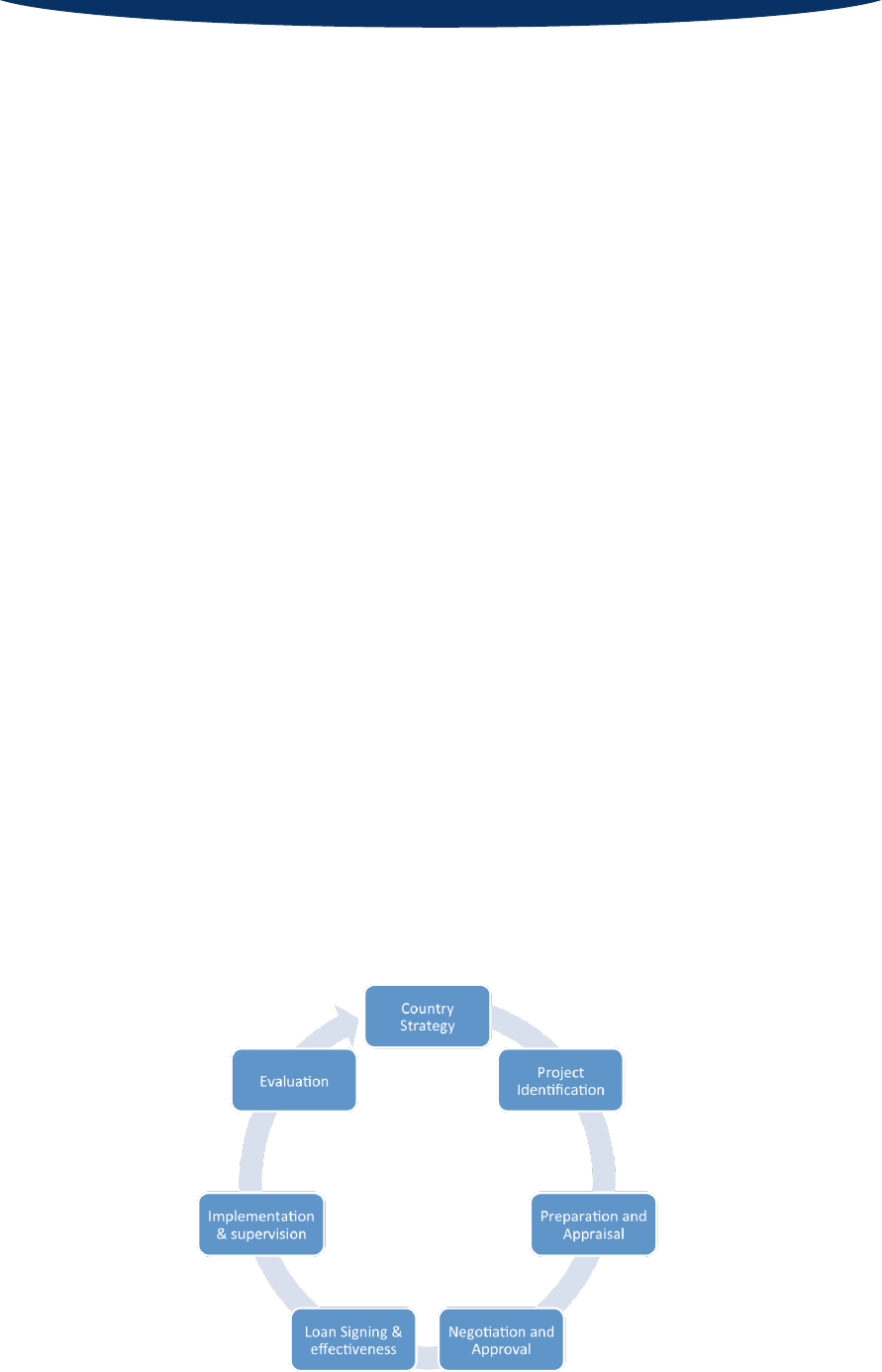
Credit Enhancement for Green Projects 28
country to collate and conceive relevant information for the project preparation. The appraisal is driven by the MDB
through the preparation of internal documentation for approval of its management. This documentation is published
after approval.
Negotiation and Approval
Once the project has been appraised thoroughly by the MDB and the country, it enters the negotiation stage where
the terms and conditions of the loan are decided. This stage is crucial since it requires the definition of the amounts
and forms to cover the risks of the project. A credit-enhancement or loan proposal is submitted to the Board of
Directors for approval. The country then enters into negotiation with the MDB as to the terms of the loan (the
amount, financing plan, disbursements, execution and completion of the project).
Loan Signing and Eectiveness
After the loan terms have been negotiated and approved within the MDB, it is then sent to the government of
the respective country for approval from the relevant cabinet of ministers. Upon receipt of the confirmed loan
documentation, the representatives from the MDB and the country’s government sign it. Disbursement or
eectiveness will usually happen after certain conditions of the agreement are met.
Implementation and Supervision
The project is administered in the country together with technical assistance of the MDB and recruitment of project
consultants as required. Tender documents are prepared to procure goods and services to carry out the project.
This is performed following the MDB’s procurement guidelines and under its supervision. The actual time period for
implementation of a project varies depending on the nature of the project.
Evaluation
Once the project has been implemented, a team from the MDB conducts evaluations of the project’s progress to
measure the outcomes against the terms set out in the loan. This is done at regular intervals, with the focus on
the development in the country with the overall strategy as a lead. The completion of the project and the ongoing
assessment of its status feed into the country strategy to ensure that the goals set out in the strategy are being met
with the implementation of the project.
Source: Author diagram.
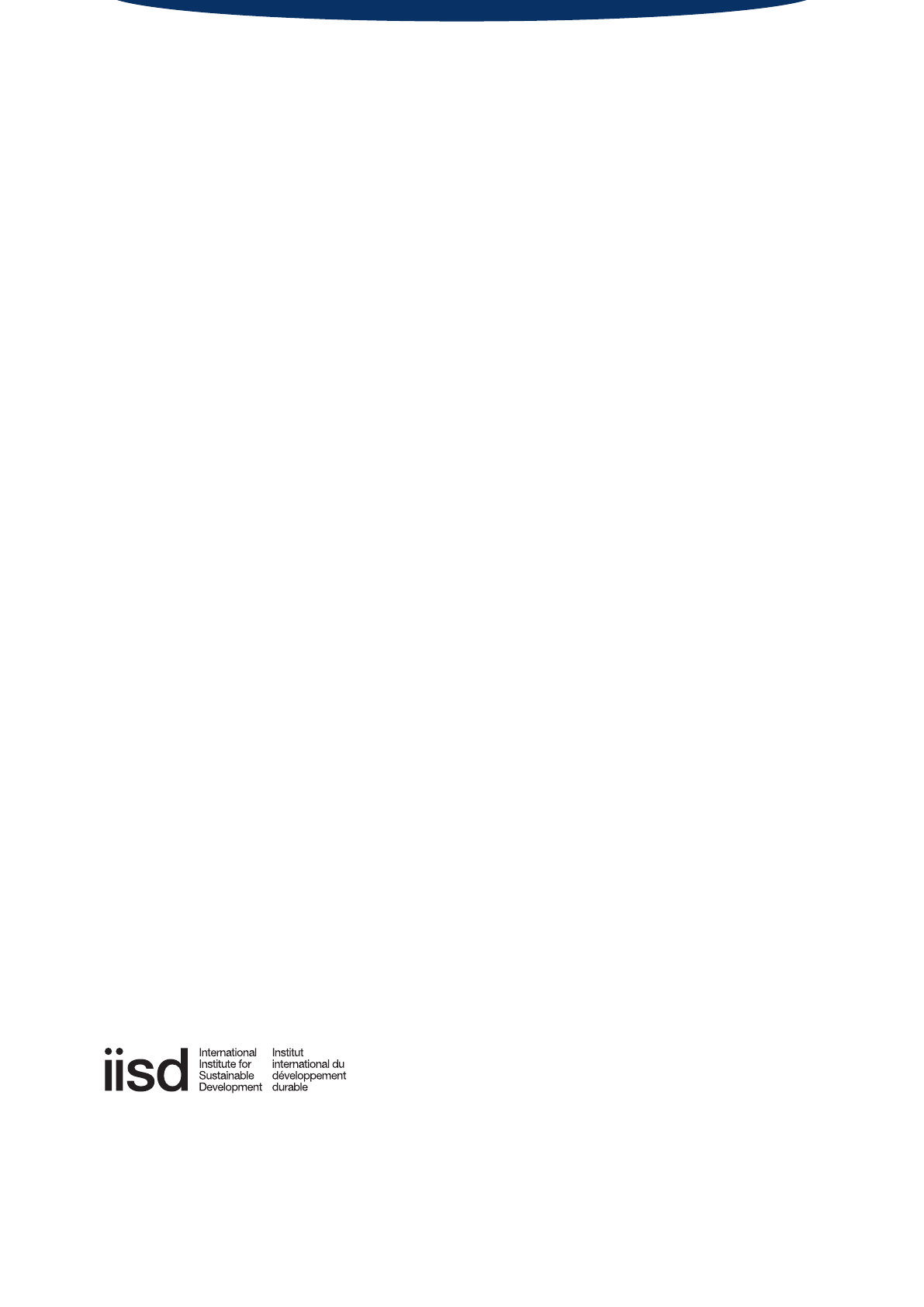
www.iisd.org/gsi © 2014 The International Institute for Sustainable Development
©2015 The International Institute for Sustainable Development
Published by the International Institute for Sustainable Development.
International Institute for Sustainable Development
Head Oce
161 Portage Avenue East, 6th Floor, Winnipeg, Manitoba, Canada R3B 0Y4
Tel: +1 (204) 958-7700 | Fax: +1 (204) 958-7710 | Website: www.iisd.org
Geneva Oce
International Environment House 2, 9 chemin de Balexert, 1219 Châtelaine, Geneva, Switzerland
Tel: +41 22 917-8373 | Fax: +41 22 917-8054 | Website: www.iisd.org
www.iisd.org
